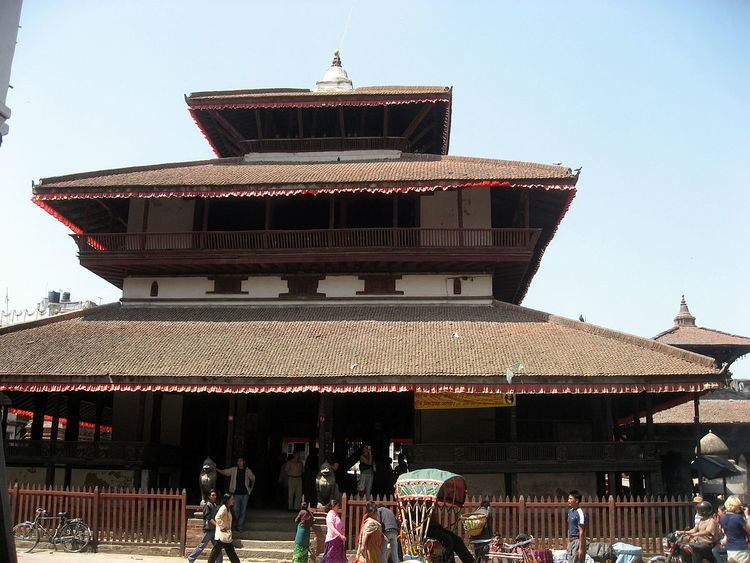 | ||
Similar Hanuman Dhoka, Kathmandu Durbar Square, Swayambhunath, Durbar Square, Boudhanath | ||
Kasthamandap temple and around during the may 12 earthquake
Kasthamandap (Sanskrit: काष्ठमन्डप, Nepal Bhasa:मरु सत्तल Maru Sattal; literally "Wood-Covered Shelter") was a three-storied public shelter that included a shrine consecrated to Gorakshanath situated at Maru, Kathmandu. The capital of Nepal. Several myths and stories about the date of the construction of the Kasthamandap Temple have been resolved with the recent archeological findings. The newly discovered objects during the excavation here in the aftermath of the earthquake have suggested that the Kasthamandap may have been built in the 7th century during the Lichhavi era.
Contents
- Kasthamandap temple and around during the may 12 earthquake
- Samay reconstructing kasthamandap
- 2015 Nepal earthquake and subsequent excavations
- References
Before this, it was assumed that the Kasthamandap was built in around the 12th century.
A team of international and national experts from the Department of Archaeology (DoA), Government of Nepal and Durham University had dug beneath the Kasthamandap some seven months back.
During the excavation, coal and sand were found at the foundation of the Kasthamandap. The foundation soil, coal and sand were taken to Starling University of London for carbon and Optically Stimulated Luminescence (OSL) tests. Following a nearly 7-month-long lab test, the result proved that the Kasthamandap Temple was built in the 7th century, said Ram Kunwar, spokesperson at the Department of Archeology (DoA).
Senior archeologist Kosh Prasad Acharya, who was involved in the team led by experts from Durham University, said that the result of the lab test of the coal found during the excavation proved that it was 2,200 years old, and it was a farming land before the construction of the Kasthamandap.
The team is now carrying out excavation works of the Kasthamandap with financial and technological support of the National Geographic Society and Art and Humanities Research Council.
It is said that the Kasthamandap was built from the timber of a single tree. Scientific tests of the sample wood are also being conducted to see if this is the case.
It was revealed that there was no fault with the construction of the Kasthamandap’s foundation, but a fault was found in the construction process above it.
Among the four pillars, one pillar was not erected due to negligence, so the Kasthamandap was destroyed by last year's earthquake, said the experts.
The foundation of the heritage was found strongly built using the traditional method. During the cleaning of the debris, more damage was done by the use of dozers, they said.
Samay reconstructing kasthamandap
2015 Nepal earthquake and subsequent excavations
On 25 April 2015, Kasthamandap temple along with many others on the Kathmandu Durbar Square, was damaged and collapsed by the April 2015 Nepal earthquake, which had an estimated magnitude of 7.9(Mw).
During the excavations, copperplate inscriptions mentioning of Jayasthithi Malla, Jyotir Malla and Yogmati Bhattarika have been recovered from a pillar of the Kasthamandap Temple. In the manuscripts dated Nepal Sambat 499, 454 and 543, (AD 1288, 1243, 1332) it is written that the person responsible for operating the Pachali Bhairav Jatra has to organise the festival following the specific regulations.
